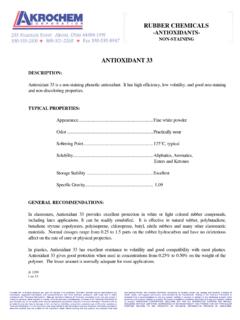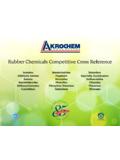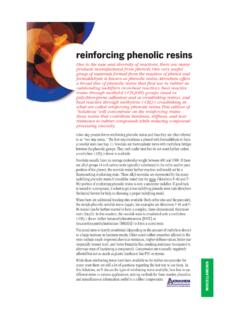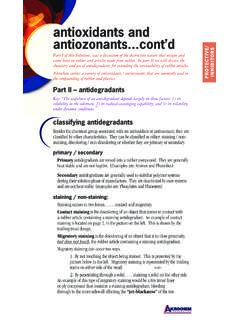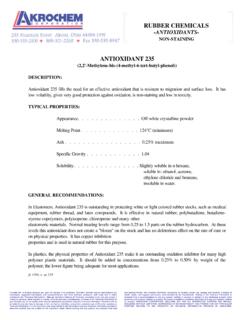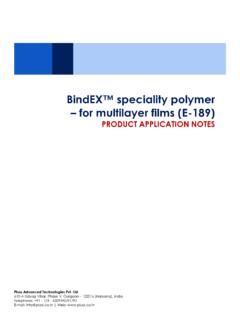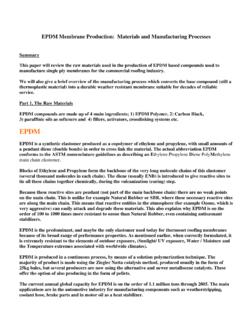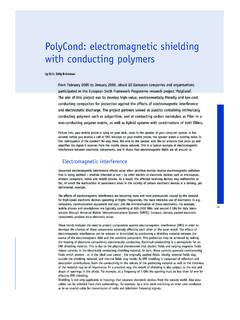Transcription of retarders for rubber cures - Akrochem
1 retarders in the rubber industry are in an unusual position some rubber technologistsinsist that retarders aren t needed and are the sign of a poorly thought-out cure system. Yetcopious amounts of retarders are consumed in the rubber business every year. While there issome truth to the fact that retarders are sometimes quick-fix bandages for problem stocks,their utility in a variety of situations makes them a critical component of a rubber compounder stoolbox of rubber idealized retarder would have the following attributes: scorch time at processing temperatures (as measured by the 2, 3 or 5 point rise at 250-270 F best known as T2, T3 or T5) is increased significantly, scorch time at molding temperatures may be slightly longer but not much, time to reach 90% of cure (T90) is not delayed, maximum rheometer torque (state-of-cure) is not changed significantly, cost is not course, no retarder meets all these qualities.
2 As a compounder, one must decide whichretarder gives the maximum benefit with minimum deficiencies. Choice of the retarder dependson the polymer to be used, the cure system, the curing parameters needed (a steam vulcanizer-cured part could afford to lose some T90 cure rate without an effect on part cost; an injectionmolded part must keep T90 time to a minimum), inventories (is it worth bringing in anew raw material to have the optimized retarder or can a currently inventoried retarder satisfythe minimal requirements?), and finally in choosing your retarder , the sometimes essentialdetails: discoloration, possibility of bloom, FDA status, ability of some retarders to reducereversion, cost, virtually all compounders know how retarders are used in the rubber industry,there are a few applications for retarders that might spark some thoughts: The most common use of retarders is to give a marginally processing stock a little more scorch time.
3 This might involve increasing the flow time in a mold or allowing a calendarto be run at a higher temperature to smooth a calendared sheet. You may have developed a compound that meets all the required specifications, the mold is cut and sample parts need to be made. However, the cavities continue to underfill increasing the shot orpreform weight just leads to thick flash and flow you can make minor changes in the compound, the simplest treatment is to use a smallamount of retarder to gain some flow time. You want to choose a retarder that minimizesfinal physical property changes so an enormous amount of re-testing is not required.
4 Youmay even choose retarders that improve certain marginal properties (a good example isusing retarder SAFE in nitriles where the retarder improves processing time and also raisesthe state-of-cure and reduces compression set). A stock runs consistently well for nine months out of the year. But during the summermonths the combination of higher ambient temperatures, oppressive warehouse temperatures,hotter running processing equipment, and higher humidity lead to curing forrubber curesDepth and Understanding: Choosing the correct retarder for a situationmay involve a number of variables: cost, efficiency, effect on the compound,and in-house availability.
5 This Solutions examines the various retarders inuse and how to optimize your choice of retarder depending on the polymerand cure DECADES OF SUPERIOR SERVICEA krochem RetarderChemical Type Uses and CommentsRetarder BA and BAXbenzoic acidWeak acid; improves shelf aging; activates cure; reduces compound SAXsalicylic acidModerate acid; moderate retarding of thiazoles; promotes reversion resistance; activates PXphthalic acidBest retarding acid with thiazoles; minimal effect on AKmodified phthalicPhthalic acid with activation Retards sl. less than PX but cures SAFE sulfonamideGood retarder in most systems; v. strong cure activation; reduces reversion.
6 High CTPN-(cyclohexylthio)Outstanding retarder with most phthalimide systems; very effective with sulfenamides. Low dosages ( phr) are G4, 5 Use with halobutyls and sulfur- methylbenzotriazolemodified polychloroprene. Not for mill small amount of retarder can often relieve this seasonal variation without affecting the compound properties. Some companies run a summer stock and a winter stock. It s probablya better idea to leave the retarder in year-round rather than having two stocks that you haveto stay aware of making the next seasonal change. Recovery of scorchy material: The cooling water chiller breaks down and ten batches of a finely tuned injection stock are mixed with excess heat input.
7 Compound properties are OK,but there is no way the presses can handle the short scorch. Adding a retarder while minimizing property changes can allow the stock to be molded. There are various waysto get the retarder in: run the stock back through the mixer; mill mix on a cold mill(a predispersed masterbatch of the retarder is preferred here); or for stock so marginal thatreworking is questionable, add retarder to fresh batches and add the scorchy stock to the fresh batches on a cold dump mill and mill blend. The trick in retarder selection is whetheryou can bring a stock back without large physical property changes or without having to use so much retarder that bloom occurs.
8 Certain products require the raw stock to be warehoused for long times. Or stocks may haveto be transported long distances in hot trucks. While refrigerated trucks are an option, a sufficient safeguard in many cases may be to add some retarder to the compound. Increase Productivity: This may take the form of parts that can be molded at higher temperatures; stocks that can be run hotter and faster through an extruder or calendar; orgoing from a two-pass mix to a one pass. For example: Production mixing time is at a premium. Mixing is done on one shift only plus some overtime. Reducing a two-pass mixedstock to a single-pass mix will not only reduce the cost of that stock, but reduce overtime needs as well.
9 Conversion to a one-pass mix starts with a good retarder . However, the use of a retarder to allow the addition of cure in a higher-temperature-mix is only one part ofconverting a two-pass mix to one-pass. The mixer must be in good enough shape to adequately mix the stock in a shorter overall mix time. Good cooling should be present in the mixer and the dump mill. Finally, certain materials may be a problem whenone-passed, like insoluble sulfur, reactive phenolic resins, and fabric bonding far we ve only discussed retarders in generalities. Let s look at specific retarders andhow they differ from one FOR rubber cures :continuedSUMMARY OF retarders FOR SULFUR CURESMATERIALS2 retarders FOR rubber cures :continuedSee Table I and Table II for a brief look at the effectiveness of various retarders with a sulfenamideor a thiazole (FormulaAwithMBTS)Little advantage is gained by using CTP or SAFE with a thiazole.
10 Cost effectiveness would go to theacid retarders . CTP is at its maximum usage level here due to bloom, whereas the PX and AK couldbe doubled at a lower cost than either of the sulfenamide AKRetarder PXRetarder SAFE retarder CTPno retarder phthalic anhydride phthalic anhydride sulfonamide N-(cyclohexylthio)modifiedphthalimideT5 @ 270 F(min)TABLE (FormulaAwithBBTS)CTP is a very powerful retarder with sulfenamides. SAFE is good while PX and AK are modest retarderswith a sulfenamide. BAX and SAX have little AKRetarder PXRetarder SAFE retarder CTPno retarder phthalic anhydride phthalic anhydride sulfonamide N-(cyclohexylthio) @ 270 F(min)TABLE s retarder BAX (benzoic acid), retarder SAX (salicylic acid), retarder AK(modified phthalic anhydride), and retarder PX (phthalic anhydride) represent the range ofacid retarders are most effective with basic accelerators like MBT, MBTS, DPG, DOTG,and Accelerator 40B (aldehyde-amine).
